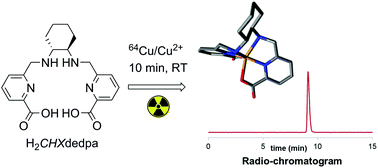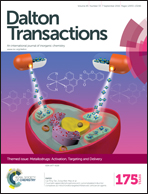Evaluation of H2CHXdedpa, H2dedpa- and H2CHXdedpa-N,N′-propyl-2-NI ligands for 64Cu(ii) radiopharmaceuticals†
Abstract
The chiral acyclic “pa” ligand (pa = picolinic acid) H2CHXdedpa (N4O2) and two NI-containing dedpa analogues (H2CHXdedpa-N,N′-propyl-2-NI, H2dedpa-N,N′-propyl-2-NI, NI = nitroimidazole) were studied as chelators for copper radiopharmaceuticals (CHX = cyclohexyl, H2dedpa = 1,2-[[carboxypyridin-2-yl]methylamino]ethane). The hexadentate ligand H2CHXdedpa was previously established as a superb system for 67/68Ga radiochemistry. The solid state X-ray crystal structures of [Cu(CHXdedpa-N,N′-propyl-2-NI)] and [Cu(dedpa-N,N′-propyl-2-NI)] reveal the predicted hexadentate, distorted octahedral binding of the copper(II) ion. Cyclic voltammetry of [Cu(dedpa-N,N′-propyl-2-NI)] shows that there is one reversible couple associated with the NI redox, and one irreversible but reproducible couple attributed to the Cu(II)/Cu(I) redox cycle. Quantitative radiolabeling (>99%) of CHXdedpa2− and (dedpa-N,N′-propyl-2-NI)2− with 64Cu was achieved under fast and efficient labeling conditions (10 min, RT, 0.5 M sodium acetate buffer, pH 5.5) at ligand concentrations as low as 10−6 M. In vitro kinetic inertness studies of the 64Cu labelled complexes were studied in human serum at 37 °C over 24 hours; [64Cu(CHXdedpa)] was found to be 98% stable compared to previously investigated [64Cu(dedpa)] which was only 72% intact after 24 hours.

- This article is part of the themed collection: Metallodrugs: Activation, Targeting, and Delivery


 Please wait while we load your content...
Please wait while we load your content...